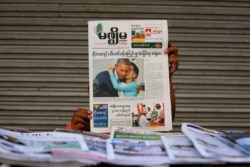People in Myanmar have one less place to access news after the San Taw Chain, or Standard Times, newspaper announced that its print and online publications will temporarily cease because of disruptions to communications and distribution in the aftermath of the coup.
The paper is the latest privately owned news outlet to suspend operations. Four other privately owned outlets, including the English-language Myanmar Times, have announced they are suspending publications since the February 1 military coup.
And on March 8, the military revoked the licenses for five organizations including Myanmar Now, Khit Thit Media, Mizzima, and Democratic Voice of Burma.
All had been reporting on the current situation in Myanmar after the military overthrew the civilian government over unproven claims of election fraud and arrested senior leaders of the National League for Democracy party, including Aung San Suu Kyi.
Media analyst Sithu Aung Myint told VOA Burmese the country’s independent media is facing challenges. News outlets are mindful of the public’s need for free and fair press as well as the threat of censorship, the analyst said.
Two state-owned daily newspapers and the state-run Myanmar Radio and Television and military-run Myawaddy TV are still operating.
International rights groups have condemned the military’s decision to suspend licenses for news outlets.
“Revoking the licenses of independent media outlets that have been providing vital information about ongoing events in the country is a draconian measure that amounts to direct censorship and breaches fundamental rights and international standards, to which Myanmar has committed,” Barbara Trionfi, executive director of the Vienna-based International Press Institute, said in a statement.
The Paris-based Reporters Without Borders (RSF) called on the U.N. to take action.
“The UN Security Council must lose no time in reaching an agreement to sanction the ruling junta’s commanders and cut short their escalation towards the complete elimination of press freedom,” Daniel Bastard, head of RSF’s Asia-Pacific desk, said in a statement.
The U.N. this week expressed concern over increased violence in Myanmar, saying that at least 149 people have been killed since February 1, including at least 11 Monday and 57 over the weekend.
At least 37 journalists have been arrested, 19 of whom are still held in detention, the U.N. said, adding that access to information continues to be threatened by the increased use of martial law as well as “state imposed communications block-outs.”
The head of Myanmar’s State Administrative Council press team, Brigadier General Zaw Min Tun, said at a March 11 news conference that the military “respects and values media freedom” and has only arrested journalists who were inciting unrest.
VOA's Khin Soe Win and Jessica Blatt contributed to this report.












